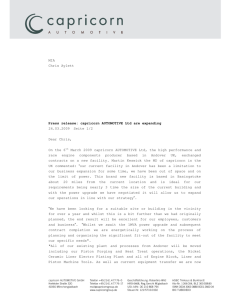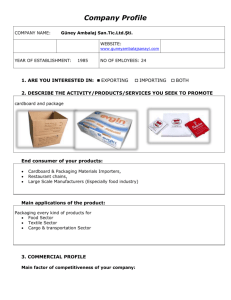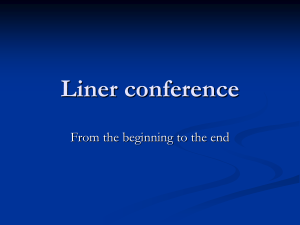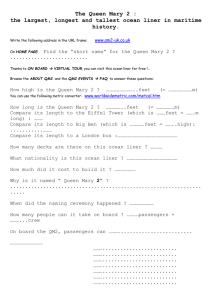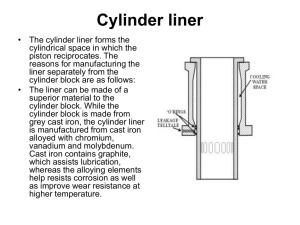04_Cylinder Liners
advertisement
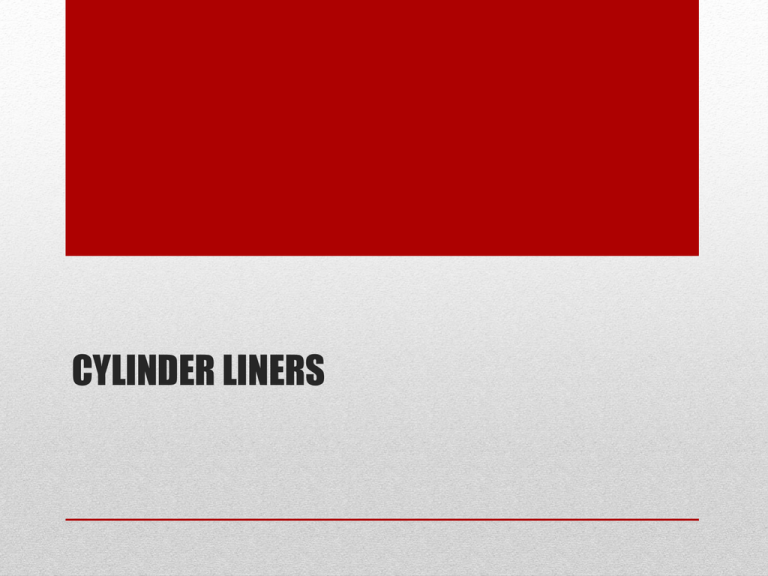
CYLINDER LINERS 1. LINER DEFINITION A removable component, cylindrical in shape, inserted into the engine block. It can be replaced when worn out. 1. LINER DEFINITION A removable component, cylindrical in shape, inserted into the engine block. It can be replaced when worn out. 1.1 FUNCTION It provides the surface for the piston to slide and carry out its compression task. 1. LINER DEFINITION A removable component, cylindrical in shape, inserted into the engine block. It can be replaced when worn out. 1.1 FUNCTION It provides the surface for the piston to slide and carry out its compression task. 1.2 TYPES Wet liners ( the water is in direct contact with outer surface of the liner ); 1. LINER DEFINITION A removable component, cylindrical in shape, inserted into the engine block. It can be replaced when worn out. 1.1 FUNCTION It provides the surface for the piston to slide and carry out its compression task. 1.2 TYPES Wet liners ( the water is in direct contact with outer surface of the liner ); Dry liners ( the water is in indirect contact with outer surface of the liner, i.e. cylinder casting contains wet jackets ). 1. LINER DEFINITION A removable component, cylindrical in shape, inserted into the engine block. It can be replaced when worn out. 1.1 FUNCTION It provides the surface for the piston to slide and carry out its compression task. 1.2 TYPES Wet liners ( the water is in direct contact with outer surface of the liner ); Dry liners ( the water is in indirect contact with outer surface of the liner, i.e. cylinder casting contains wet jackets ). 1.3 MANUFACTIRING Grey cast steel + vanadium & titanium Chromium plate liners ( to reduce wear rate ), Close grained cast iron or Fine lamellar cast iron ( in recent designs ). 1.3 MANUFACTIRING What are the reasons for manufacturing the liner separately from the cylinder block? 1. A liner can be manufactured using a superior material to the cylinder block (grey cast steel + alloys to help resist corrosion and improve wear resistance at high temperatures) 2. Replacing a worn liner. 3. At working temperature, the liner is hot. It will expand more and is free to expand diametrically and lengthwise. If they were cast as one piece, then unacceptable thermal stresses would be set up, causing fracture of the material. 4. Less risk of defects. The more complex the casting, the more difficult to produce a homogenous casting with low residual stresses. 1.4 CONDITIONS TO MEET Strength, wear resistance & corrosion resistance ( sulphur in fuel ). 1.5 LIMITATIONS Thickness ( 0,085D – 0,1D ) because of: cooling and thermal stresses. 1.4 CONDITIONS TO MEET Strength, wear resistance & corrosion resistance ( sulphur in fuel ). 1.5 LIMITATIONS Thickness ( 0,085D – 0,1D ) because of: cooling and thermal stresses. 1.6 CONNECTIONS AND ARRANGEMENTS* 1.6.1 Connections At the top – flange ( for securing in the cylinder block or to the water jacket ). 1.4 CONDITIONS TO MEET Strenght, wear resistance & corrosion resistance ( sulphur in fuel ). 1.5 LIMITATIONS Thickness ( 0,085D – 0,1D ) because of: cooling and thermal stresses. 1.6 CONNECTIONS AND ARRANGEMENTS* 1.6.1 Connections At the top – flange ( for securing in the cylinder block or to the water jacket ). 1.6.2 Arrangements Below the top flange – joint ring ( copper or heat resistant rubber ); 1.4 CONDITIONS TO MEET Strenght, wear resistance & corrosion resistance ( sulphur in fuel ). 1.5 LIMITATIONS Thickness ( 0,085D – 0,1D ) because of: cooling and thermal stresses. 1.6 CONNECTIONS AND ARRANGEMENTS* 1.6.1 Connections At the top – flange ( for securing in the cylinder block or to the water jacket ). 1.6.2 Arrangements Below the top flange – joint ring ( copper or heat resistant rubber ); Lower end of the liner – rubber ring seal for the bottom of water space. 1.4 CONDITIONS TO MEET Strenght, wear resistance & corrosion resistance ( sulphur in fuel ). 1.5 LIMITATIONS Thickness ( 0,085D – 0,1D ) because of: cooling and thermal stresses. 1.6 CONNECTIONS AND ARRANGEMENTS* 1.6.1 Connections At the top – flange ( for securing in the cylinder block or to the water jacket ). 1.6.2 Arrangements Below the top flange – joint ring ( copper or heat resistant rubber ); Lower end of the liner – rubber ring seal for the bottom of water space. Between the upper & lower rings – leak-off hole ( a drain for oil & water out of the engine ). 1.7 DESIGN Uninterrupted or continuous liner ( in 4-stroke engines ); 1.7 DESIGN Uninterrupted or continuous liner ( in 4-stroke engines ); Ported liner ( 2-stroke engines ) 1.7 DESIGN Uninterrupted or continuous liner ( in 4-stroke engines ); Ported liner ( 2-stroke engines ) 1.8 SCAVENGING Traditional two stroke loop scavange engines have ports midway along their length; 1.7 DESIGN Uninterrupted or continuous liner ( in 4-stroke engines ); Ported liner ( 2-stroke engines ) 1.8 SCAVENGING Traditional two stroke loop scavange engines have ports midway along their length; Modern two stroke engines are provided with uniflow scavenging system. 2. COOLING* 2.1 PURPOSE Reduction of the surface temperature allows for adequate lubrication, ensures gas seal & diminishes liner & piston ring wear. Limiting thermal expansion thereby maintaining the piston clearance. 2. COOLING* 2.2 IN WET LINERS By circulation of chemically treated fresh water ( to reduce corrosion and prevent scale formation ) in the upper ends of liners. More effective cooling may be obtained by bore-cooled liners, i.e. through additional drillings for cooling water made. On some large bore, long stroke engines it was found that the undercooling further down the liner was taking place. Why is this a problem? The hydrogen in the fuel combines with the oxygen and burns to form water. Normally this is in the form of steam, but if it is cooled it will condense on the liner surface and wash away the lube oil film. Fuels also contain sulphur. This burns in the oxygen and the products combine with the water to form sulphuric acid. If this condenses on the liner surface, then corrosion can take place. Once the oil film has been destroyed then wear will take place at an alarming rate. One solution is to insulate the outside of the liner so that there was a reduction in the cooling effect. On the latest engines, the liner is only cooled by water at the very top, relying on the air in the scavenge space to cool the lower part of the liner. The photo shows a cylinder liner with the upper and mid insulation bands known as "Haramaki„. Although Haramaki is a type of Japanese armour, the word also means literally " Stomach or Body Warmer". i.e. an insulator. 3. LUBRICATION* 3.1 PURPOSE To reduce piston ring friction & wear; Oil film acts as gas seal to ( prevent blow by ) & corrosion inibitor; 3.2 TYPE In large crosshead-type engines – sepatate cylinder lubrication system fitted. In trunk piston engines – by oil splashing from the crankcase. 3. LUBRICATION* 3.1 PURPOSE To reduce piston ring friction & wear; Oil film acts as gas seal to ( prevent blow by ) & corrosion inibitor; 3.2 TYPE In large crosshead-type engines – sepatate cylinder lubrication system fitted In trunk piston engines – by oil splashing from the crankcase. 3.3 OIL INJECTION Through lubricator quills – timed to inject oil between the piston rings as they pass. 4. GAUGING* It is made internally during cylinder overhaul after 6000 – 8000 hours. 4.1 GAUGE ( micrometer & extension bar / template bar / gauging strip). 4. GAUGING* It is made internally during cylinder overhaul after 6000 – 8000 hours. 4.1 GAUGE ( micrometer & extension bar / template bar / gauging strip ). 4.2 READINGS ( at 6 – 8 vertical positions – total wear from original & wear since last recording ) 4. GAUGING* It is made internally during cylinder overhaul after 6000 – 8000 hours. 4.1 GAUGE ( micrometer & extension bar / template bar / gauging strip). 4.2 READINGS ( at 6 – 8 vertical positions – total wear from original & wear since last recording ) 4.3 WEAR RATES* High at the beginning, later almost constant ; acceptable wear – 0.1 mm per 1000 hours; maximum wear before renewal – app. 0.6-0.8 % of the original diametar ) 5. WEAR CAUSES & RESULTS / REMEDIES 5. WEAR CAUSES & RESULTS / REMEDIES 5.1 FRICTIONAL WEAR ( between the liner surface & rings ) It depends upon: material, surface conditions, efficiency of lubrication, piston speed, engine loading, maintenance of piston rings, combustion efficiency & contamination of air and fuel. 5.2 CORROSION ( lower part of the liner ) engines burning heavy fuel & high sulphur content fuel – to be neutralised by alkaline type cylinder oil; too low jacket cooling water temperature leads to sulphuric acid corrosion – keep jacket temperatures above dew point. the charge air intercooler is undercooled and condensed water droplets are carried into the cylinder by scavenge air. 5.3 ABRASION ( hard particles ) Products of mechanical wear, corrosion & combustion – cylinders to be regularly cleaned and inspected. 6. RENEWAL & PREPARATION FOR RUNNING-IN 6.1 RENEWAL At the top of the piston travel & at port bars ports to be cleaned, sharp edges to be removed, lubricators to be tested, possible cracks to be inspected 6.2 PREPARATION FOR RUNNING-IN* New liners are produced with slightly rough surface to retain oil & facilitate running in. Used liners require honing ( breaking the liner glaze ). 6. RENEWAL & PREPARATION FOR RUNNING-IN 6.1 RENEWAL At the top of the piston travel & at port bars ports to be cleaned, sharp edges to be removed, lubricators to be tested, possible craks to be inspected 6.2 PREPARATION FOR RUNNING-IN* New liners are produced with slightly rough surface to retain oil & facilitate running in. New liners require honing ( breaking the liner glaze ). Hard wearing surfaces are obtained by liner bore nitrading.

